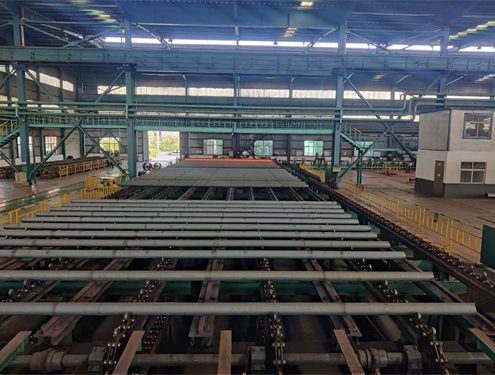Austenitic stainless steel should also pay attention to: cold work hardening, high temperature aging embrittlement
Everyone is familiar with the intergranular corrosion and stress corrosion cracking problems of austenitic stainless steel.
The intergranular corrosion tendency test of stainless steel is common content in design documents, and the relevant content in standards such as HG/T 20581 is also relatively clear. The hydrostatic test or the chloride ion content in the operating medium is also a basic concern when designing austenitic stainless steel equipment. In addition to chloride ions, wet hydrogen sulfide, polythionic acid, and other environments that may produce sulfides can also cause stress corrosion cracking of austenitic stainless steel.
It is worth mentioning that although austenitic stainless steel is not mentioned in the chapter on wet hydrogen sulfide corrosion in HG/T 20581, the reference literature points out that austenitic stainless steel has a much greater ability to dissolve atomic hydrogen than ferritic steel. , but hydrogen-induced wet hydrogen sulfide stress corrosion cracking will still occur, especially after the deformation martensitic structure transformation occurs during cold work hardening.

Cold work hardening increases stress corrosion cracking susceptibility
Austenitic stainless steel has excellent cold working properties, but its work hardening is very obvious. The greater the degree of cold working deformation, the higher the hardness rises. Increased hardness due to work hardening is also an important cause of stress corrosion cracking in stainless steels, especially those in the base metal rather than the weld.
There are some cases below:
The first type of case is after austenitic stainless steel is cold-spinning to process an elliptical or disc-shaped head, the cold deformation in the transition zone is the largest, and the hardness also reaches the highest. After it was put into use, chloride ion stress corrosion cracking occurred in the transition zone, causing equipment leakage.
The second type of case is a U-shaped corrugated expansion joint made by hydroforming after rolling stainless steel plates. The cold deformation is the largest at the wave crest, and the hardness is also the highest. The most stress corrosion cracking occurs along the wave crest, and cracks occur along a circle of wave crests. Explosion accident involving low-stress brittle fracture.
The third type of case is stress corrosion cracking of corrugated heat exchange tubes. Corrugated heat exchange tubes are cold extruded from stainless steel seamless tubes. The crests and troughs are subject to varying degrees of cold deformation and thinning. The crests and troughs may cause several stress corrosion cracks.
The essence of cold work hardening of austenitic stainless steel is the generation of deformation martensite. The greater the cold working deformation, the more deformation martensite is produced and the higher the hardness. At the same time, the internal stress inside the material is also greater. if solid solution heat treatment is performed after processing and forming, the hardness can be reduced and the residual stress can be greatly reduced. At the same time, the martensite structure can also be eliminated, thereby avoiding stress corrosion cracking.
Embrittlement problems caused by long-term service at high temperatures
Currently, Cr-Mo steel with higher high-temperature strength is the main material for containers and pipes at temperatures between 400 and 500°C, while various austenitic stainless steels are mainly used at temperatures between 500 and 600°C or even 700°C. In design, people tend to pay more attention to the high-temperature strength of austenitic stainless steel and require that its carbon content not be too low. The allowable stress at high temperatures is obtained by extrapolating the high-temperature endurance strength test, which can ensure that no creep rupture will occur during 100,000 hours of service under the design stress.
However, the problem of age embrittlement of austenitic stainless steel at high temperatures cannot be ignored. After long-term service at high temperatures, austenitic stainless steel will undergo a series of structural changes, which will seriously affect a series of mechanical properties of the steel, especially the brittleness It increased significantly and the toughness decreased significantly.
The embrittlement problem after long-term service at high temperatures is generally caused by two factors, one is the formation of carbides, and the other is the formation of σ phase. The carbide phase and σ phase continue to precipitate along the crystal after the material has been in service for a long time and even form continuous brittle phases on the grain boundaries, which can easily cause intergranular fracture.
The formation temperature range of the σ phase (Cr-Fe intermetallic compound) is approximately 600 to 980°C, but the specific temperature range is related to the alloy composition. The result of the precipitation of σ phase is that the strength of austenitic steel increases significantly (the strength may be doubled), and it also becomes hard and brittle. High chromium is the main reason for the formation of the high-temperature σ phase. Mo, V, Ti, Nb, etc. are alloy elements that strongly promote the formation of σ phase.
The formation temperature of carbide (Cr23C6) is in the sensitization temperature range of austenitic stainless steel, which is 400~850 ℃. Cr23C6 will dissolve above the upper limit of the sensitization temperature, but the dissolved Cr will promote the further formation of the σ phase.
Therefore, when austenitic steel is used as heat-resistant steel, the understanding and prevention of high-temperature aging embrittlement should be strengthened. Just like the metal monitoring in thermal power plants, the metallographic structure and hardness changes can be regularly inspected. If necessary, samples can be taken out for metallographic and hardness inspections, and even comprehensive mechanical properties and durable strength tests can be conducted.


